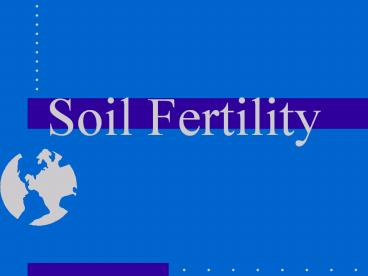Soil Fertility - PowerPoint PPT Presentation
1 / 25
Title:
Soil Fertility
Description:
Soil Fertility Terms and ... Important to germinating seedlings Contributes to early maturing crops Necessary for seed and fruit formation ... Factors that Influence ... – PowerPoint PPT presentation
Number of Views:316
Avg rating:3.0/5.0
Title: Soil Fertility
1
Soil Fertility
2
Terms and definitions
- Essential Nutrient- Element necessary for plant
growth and reproduction, for example nitrogen,
phosphorus, and potassium. - Deficiency- Plant condition where an essential
nutrient is not sufficiently available. - Symptom- A visual sign or condition that results
from a deficiency symptoms aids in diagnosing a
deficiency.
3
More Terms and Definitions
- Fertilizer- Natural, manufactured, or processed
material or mixture of materials that contains
one or more of the essential nutrients availible
in - dry form
- liquid form
- gaseous form
4
Fertilizer Terms
- Analysis- Percentage water soluble content of
nitrogen (N), phosphorus (P) expressed as P2O5,
and potassium (K) expressed as K2O in the
fertilizer. - Brand- Trademark of the company which produced
the fertilizer. - Complete Fertilizer- Fertilizer which supplies
all three primary nutrients, (N,P,K)
5
Chemical Elements Essential To Plant Growth
- Non-mineral- air and water
- Carbon (C)
- Hydrogen (H)
- Oxygen (O)
- Nitrogen (N)
- Mineral- from the soil
- Primary
- Nitrogen (N)
- Phosphorus (P)
- Potassium (K)
- Secondary
- Calcium (Ca)
- Magnesium (Mg)
- Sulfur (S)
- Micronutrients
- Iron (Fe), Boron (B), Manganese (Mn), Copper
(Cu), Zinc (Zn), Molybdenum (Mo), Clorine (Cl)
6
10 Essential Elements
- Essential Elements
- Carbon (C)
- Hydrogen (H)
- Oxygen (O)
- Phosphorus (P)
- Potash (K)
- Nitrogen (N)
- Sulfur (S)
- Calcium (Ca)
- Iron (Fe)
- Magnesium (Mg)
C. HOPKINS CAFÉ Mighty Good
7
(No Transcript)
8
Functions of Nutrients for plant growth
- Carbon, Hydrogen, and oxygen are needed in the
plant processes of photosynthesis of
photosynthesis and respiration. - Approximately 95 of weight of plants comes from
products of photosynthesis
9
Primary Nutrient Functions
- Nitrogen (N)
- Gives green color to plant
- Induces vigorous , rapid growth in plants
- Increases protein and yield
- Aids and promotes seed and fruit development
- Nitrogen constitutes 80 of the atmosphere, yet
it is one of the most critical elements for plant
growth. - Plants cannot utilize N as a gas, it must be
combined with other elements.
10
More Primary Nutrient Functions
- Phosphorus (P)
- Important to germinating seedlings
- Contributes to early maturing crops
- Necessary for seed and fruit formation
- Stimulates root growth
11
Primary Nutrient Functions Cont.
- Potassium (K)
- Necessary for production and translocation of
carbohydrates - Produces plumper seeds
- Controls Water intake and respiration
- Stiffens straw and stalks
12
Secondary Nutrient Functions
- Sulfur (S)
- Necessary for nodule formation on legumes
- Associated with plant enzyme systems
- Stimulates seed production
- Affects protein and crop quality
13
Secondary Nutrient Functions
- Calcium (Ca)
- Speeds decay of organic matter
- Stimulates formation of nitrates
- Promotes root and leaf growth
- Necessary for nodulation of legumes
14
Secondary Nutrient Functions
- Magnesium (Mg)
- Necessary for chlorophyll or green plant color
- Increases adsorption of phosphorus
- Aids in the formations of fats and oils
- Important in plant enzyme system
15
Symptoms of nutrient deficiencies
- Review
- Deficiency- Plant condition where an essential
nutrient is not sufficiently available. - Symptom- A visual sign or condition that results
from a deficiency symptoms aids in diagnosing a
deficiency.
16
Primary nutrient deficiency symptoms
- Nitrogen (N)
- Stunted and Spindly
- Yellow, yellowish green or light green in color
in foliage (chlorosis) - Older leaves affected first, starting at the tip
and moves along the middle of the leaf.
17
(No Transcript)
18
Primary nutrient deficiency symptoms
- Phosphorus (P)
- Stunted Growth
- Very dark green color
- Purple leaves or portions of leaves in advanced
stages - Older leaves affected first
19
Phosphorus Deficiency
20
Primary nutrient deficiency symptoms
- Potassium (K)
- Shorter plants
- Bronzing or browning of leaf color
- Lodging (bending of the stem) occurs
- Leaves show yellow to brown coloring along leaf
margins followed by complete browning.
21
Potassium Deficiency
22
Secondary nutrient deficiency symptoms
- Sulfur (S)
- Young plants have stunted appearance
- Leaves have a light-green to yellow coloring
- Stems are thin and spindly
- Sulfur deficiency symptoms are similar in
appearance to nitrogen deficiency symptoms.
23
Secondary nutrient deficiency symptoms
- Magnesium (Mg)
- Leaf parts between veins show a whitish color
- Leaf tissue becomes yellow, veins remain green
(interveinal chlorosis) - Leaves curl upward along the margins
24
Deficiency Continued
- Other conditions besides deficiencies may cause
abnormal plant growth. - Cold, wet weather, lack of sunlight, disease,
insect damage, and improperly applied chemicals
are examples.
25
Factors that Influence Fertilizer Use
- Chemical and physical condition of the soil
- Crop to be grown
- Climatic Conditions
- Time

